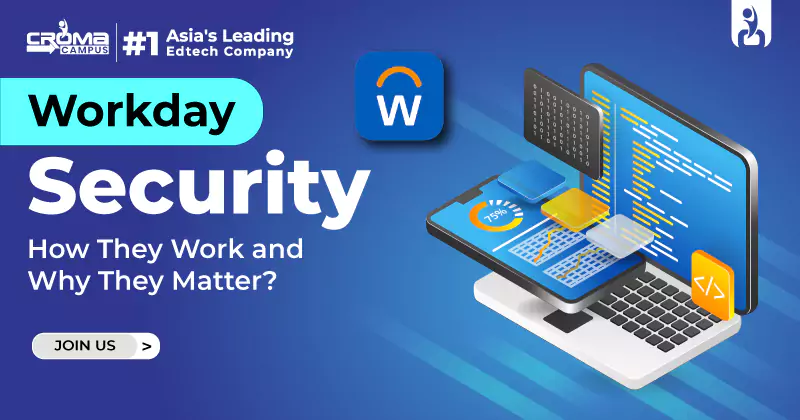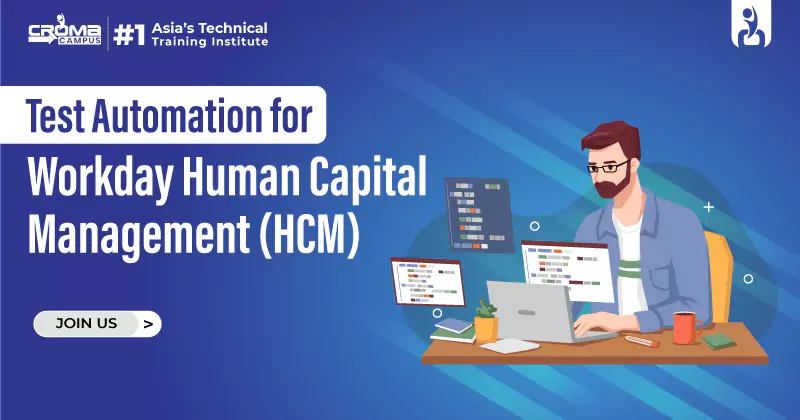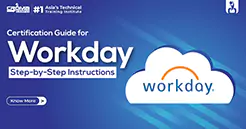Workday Security: How They Work And Why They Matter?
4.9 out of 5 based on 9785 votesLast updated on 22nd May 2025 19.2K Views
- Bookmark

Discover how Workday Security works, its key components, and why it’s essential for protecting sensitive data, ensuring compliance, and managing user access.

Workday Security Components:
Workday security elements are implemented to give solid and far-reaching security framework to organizations. The Workday Training helps you learn these essential security elements:
- Authentication: Workday's authentication controls guarantee that only licensed users have access to the system.
- Authorization: Workday's authorization model governs what activities can be executed by users within the system.
- Data Encryption: Workday encrypts data both in transit and at rest.
- Auditing and Logging: Workday supports auditing and logging features for monitoring user activity and system modifications.
Note: Boost your career with Workday Training in Noida at Croma Campus. Learn from certified experts, gain hands-on experience, and get job-ready with real-time projects. Enroll now for top-notch training and placement support.
Challenges in Maintaining Workday Security:
The protection of a Workday environment is a complicated task that must be carried out with full understanding and care to several key aspects. These include the security of data, the size of the network, type and differentiation of the protected data, and observance of legal regulations. The proper management of information assets is a must in the world of today. The issues that come with the security of Workday can be a tough nut to crack given some reasons, among them were:
- Complexity: Workday's security infrastructure is complex to manage and maintain.
- User Management: User access and permission management can be time-consuming and error-prone.
- Data Sensitivity: Workday handles sensitive employee and financial information, so it is a high-value asset for attackers to target.
- Compliance: Organizations have to adhere to different regulations, including GDPR and HIPAA, while utilizing Workday.
You May Also Read This Blog Posts:
Workday Certification Cost In India
Test Automation for Workday Human Capital Management (HCM)
How To Start Your Career With Workday HCM
What Makes Workday Software A Better Career Option For Freshers
Certification Guide For Workday
How To Prepare For The Workday Certification?
Workday Interview Questions And Answers
What Are The Job Responsibilities Of A Workday Analyst?
How Does Workday Leverage AI & Machine Learning For HR & Finance?
Common Workday Security Threats:
Workday security threats can lead to the exposure of your company's confidential data and blocking the business activities. Knowledge of the most prevalent threats like unauthorized access, data breach, insider threats, and the various phishing attacks which are pretty common is indispensable if one wants to set the foundation of practical Workday security strategies that will protect the Workday environment of the organization. There is a huge demand for professionals with Workday Certification who can neutralize these kinds of threats. There are several common Workday security threats that can be highlighted, such as:
- Unauthorized Access: Users who are not authorized to get into the system in any way, i.e., either by using somebody else's credentials or hacking the system.
- Data Breaches: When privacy data gets uncovered or stolen through security holes or due to employees' negligence or mistakes.
- Insider Threats: Members of the organization who deliberately or accidentally divulge the security information, that causes the security to be compromised with malicious intent or carelessness.
- Phishing Attacks: Email based attacks that aim at Workday users and hence, lead to leaks in the credentials or cause other similar security issues.
Threat Category | Description | Mitigation Strategy |
Phishing Attacks | Fraudulent emails to obtain user credentials or install malware | Security awareness training, email filtering |
Weak Passwords | Use of easily guessable or reused passwords | Enforce strong password policies, MFA |
Unauthorized Access | Access by users without appropriate permissions | Regular access reviews, role-based access control (RBAC) |
Insider Threats | Malicious or negligent actions by employees | User behavior analytics, least privilege principle |
Data Leakage | Exposure of sensitive data via downloads or exports | DLP tools, restrict export permissions |
API Exploits | Improper use or abuse of Workday APIs | Secure API configurations, limit API access |
Unpatched Systems | Use of outdated Workday integrations or third-party plugins | Regular patching schedule, system monitoring |
Session Hijacking | Attacker takes over a user session | Session timeout, IP restrictions, secure cookies |
Note: Looking for Workday Training in Gurgaon at Croma Campus? Join our expert-led courses designed to boost your skills in Workday modules. Gain hands-on experience, real-time projects, and industry-recognized certification. Perfect for beginners and professionals aiming to advance their careers.
Workday Security Best Practices:
The protection of your Workday environment is necessary to be assured through an active security approach that takes into account the best practices which are the most important. By adopting them, e.g. least privilege access, robust authentication, frequent monitoring, software patching, and security training, you will be able to considerably decrease the risk of security breaches and the integrity of the sensitive information will be preserved. Numerous institutes provide the Workday Finance Training and enrolling in them can help you start a career in this domain. To ensure the security of your Workday environment, the following best practices should be adhered to:
- Limit Access by Assigning the Least Privilege: Only the data and functionality a user needs to have should be given to the user and the others should be restricted.
- Use Strong Authentication: Authentication techniques that offer strong security are to be implemented such as MFA, to make sure that even if someone steals your logon credentials, they cannot log in from the unknown device without entering the password twice or more.
- Monitor User Activity: Always supervise changes in a user's activity and system operations so you can see if there are security-related issues that need to be taken care of first.
- Update Software: Keep Workday as well as third-party software updated with the latest security releases and patches.
- Conduct Security Training: Users should be given regular security training by the organization to help them understand the different security methods, and as a result, to understand the potential threats.
Related Courses:
Security Setup and Configuration in Workday:
Setting up security in Workday and making sure that it is properly configured is one of the major steps that you should take to protect the sensitive information of your organization and to fill the regulatory compliance requirements. To establish a secure environment, you can build a security plan which consists of defining the security roles, authorize the permissions, authenticate the access, ensure auditing, and logging, and finally monitor security. These five main tasks will ensure that your system will be protected and that your mission will be accomplished. In order to accomplish the first step for configuring and setting up security in Workday, go through the steps mentioned below:
- Describe Security Roles: Define security roles and access the data and features so that user access to data and functionality can be managed.
- Identify Security Roles: Defining the security roles and permissions is where the user will fit in the organization.
- Arrange Authentication: It should be possible to get to the system only if the correct authentication methods such as MFA are configured.
- Establishing Auditing and Logging: Have auditing and logging enabled to capture users' activity and the change of the system.
- Observe The Protection Against Fraud: Ensure that the security settings and the system configurations are continuously checked and up-to-date and efficient.
Security Component | Description | Responsible Role |
Security Groups | Logical groupings of users based on roles or access needs | Security Admin |
Domain Security Policies | Controls access to data in Workday domains | Security Admin / SME |
Business Process Policies | Define who can initiate, approve, or review business processes | HR Admin / Manager |
Role Assignments | Mapping of security roles to users or positions | Admin / HR Ops |
Segregation of Duties | Preventing conflicts in role permissions | Internal Controls |
Workday Authentication | Authentication method settings (SSO, MFA) | IT Security |
Integration Security | Security for APIs and integrations | Integration Admin |
Report Access Security | Controls who can view/customize reports | Reporting Admin |
Security Audit Logs | Logging of access and security events | Security Admin |
Data Masking & Visibility | Control field-level data exposure | Privacy Officer / HR |
Conclusion:
Securing your Workday environment demands an end-to-end solution that involves setting up security best practices, setting security settings, and monitoring user activity. Following the instructions in this article will enable organizations to protect their sensitive information and guarantee the security and integrity of their Workday environment.
Subscribe For Free Demo
Free Demo for Corporate & Online Trainings.
.webp)
























.webp)

.png)















